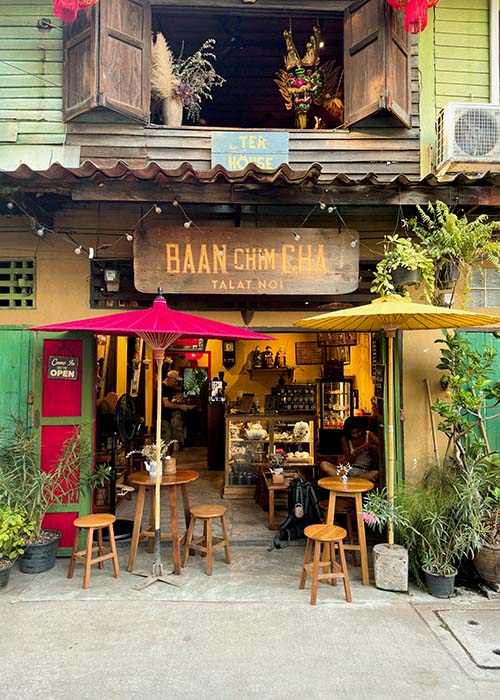
Imagine a serene morning in Chiang Mai with the sun painting the lush landscapes of gold and the air carrying the rich aroma of fresh brew. Around a rustic wooden table, a motley crew of digital nomads—folks who mix remote work with travel to live the nomad life—are either deep in a convo or glued to their laptops. They’re all soaking up the freedom to work from anywhere under the sun. This snapshot pretty much nails what digital nomadism in Thailand is all about—a top-notch spot for those keen to meld work with wanderlust.
Right at the heart of this buzzing community stands Joy Intisuk, a true trailblazer known for shaking things up in this modern work culture. As the brains and brawn behind Thailand Nomads, Joy has flipped the platform into a go-to resource for nomads the world over. Thailand Nomads is where tech meets travel, dishing out all the tools, networking chances, and must-know info to make a living and working in Thailand a walk in the park.
Joy Intisuk’s Early Life and Inspiration
Joy’s roots are in Chiang Mai, a place where age-old Thai culture dances with modern vibes. She grew up helping out at her folks’ small guesthouse, a place buzzing with travelers from every corner of the globe. Rubbing shoulders with such a global crowd sparked her fascination with world cultures and set the stage for her future pursuits.
She hit the books at Chiang Mai University, diving deep into International Business. During her college days, she got a firm grip on global markets and learned the ropes of cultural sensitivity—skills that later became her bread and butter. It was also during this period that Joy stumbled upon her knack for writing, crafting her debut piece on Chiang Mai’s secret cafés. This article was a hit and paved the way for her career as a travel writer.

Joy’s Contributions to Travel Writing and Digital Nomadism
In no time, Joy made a name for herself in travel writing, with a spotlight on Southeast Asia. She lent her voice to various travel blogs and digital nomad forums, dishing out local insights and savvy travel tips that were lapped up by readers. Her storytelling, packed with lively tales and spot-on advice, really brought the places she visited to life.
Her green thumb in promoting sustainable travel practices in Thailand didn’t go unnoticed either, underscoring her commitment to traveling responsibly. She also wore the hat of a guest editor for a few local travel mags, weaving together content that married traditional Thai culture with the burgeoning trend of digital nomadism.
Deep Dive into Joy’s Expertise and Impact
Joy’s know-how stretches way beyond travel writing; she’s a whiz when it comes to the cultural nitty-gritty of Southeast Asia. She has penned in-depth guides on Northern Thailand’s Lanna culture that help digital nomads get more than just a glimpse of local traditions, festivals, and food scenes that most tourists miss. Her work is a treasure trove of authentic insights that resonate with those looking for a deeper connection to their temporary stomping grounds.
She also gets down to brass tacks when it comes to the nuts and bolts of nomadic life. From unraveling the maze of visa regulations to picking spots that hit the sweet spot for connectivity and lifestyle, Joy’s guidance is gold. Her articles are a toolkit for nomads setting up shop in new places, filled with everything you need to hit the ground running.
Joy passionately explains her vision, “We’re not just creating spaces for digital nomads to work; we’re crafting experiences that integrate local culture and foster a deeper understanding between nomads and the communities they visit. Our goal is to make every destination more than a stopover—it’s a rich, immersive journey.”

For example, to get the ball rolling on integrating nomads into the local scene during Chiang Mai’s Lantern Festival, Joy spearheaded a series of workshops. These sessions peeled back the layers of the festival’s cultural significance, offered pro tips on engaging respectfully, and even covered how to snag photos that could jazz up any portfolio or Instagram feed.
Vision and Future Plans for Thailand Nomads
Looking ahead, Joy’s plans are to amp up Thailand Nomads with tech upgrades and fresh community features. She’s gearing up to roll out AI-driven personalization for users and a slicker interface to ensure smooth sailing across various devices. She’s picturing a virtual community board for swapping tips and planning a lineup of live-streamed workshops and virtual meet-ups to chew over key topics like local entrepreneurship and cultural integration.
Expanding the Global Footprint
Under Joy’s watch, Thailand Nomads isn’t just growing locally but also casting a wider net globally. Plans are in motion to link up with sister communities in neighboring spots like Laos, Cambodia, and Vietnam. This push aims to weave a broader network of resources that bolster the nomadic lifestyle across Southeast Asia, smoothing the path for nomads to hop between countries while keeping their living and work standards top-notch.
Practical Tools for Financial Efficiency
Beyond the inspiring workshops and cultural integration efforts led by Joy, savvy travel management remains crucial for nomads who often juggle work and wanderlust on a budget. One useful tool for this purpose is Pruvo, a service that helps travelers save money on hotel bookings even after making their reservations. By monitoring price drops and advising on rebooking at lower rates, Pruvo ensures that digital nomads can allocate more of their resources toward experiencing the richness of their destinations. For more information on how to make the most of this service, visit Travel Thru History’s website.
Community Initiatives and Outreach
Joy is gung-ho about community engagement and has kicked off several outreach programs to educate local communities in Thailand on the perks of digital nomadism. These initiatives range from workshops for local business owners on how to cater to digital nomads to community events that blend nomads and locals, nurturing understanding and cultural exchange.
Personal Interests and How They Influence Her Professional Life
Joy’s love for photography and venturing off the beaten path in Northern Thailand spices up her professional life. Her snaps, capturing stunning landscapes and cultural moments, often accompany her articles, adding a splash of visual flair to her written word.
Conclusion: The Impact of Joy’s Leadership
Joy Intisuk’s leadership at Thailand Nomads is revolutionizing the platform, turning it into a comprehensive resource supporting digital nomads’ lifestyles. By championing sustainable travel, cultural dives, and community ties, she’s reshaping what it means to live and work remotely. Under her guidance, Thailand Nomads is on track to become not just a tool for nomads but a thriving community hub that champions a balanced and enriching nomadic lifestyle.
Joy’s story is a testament to the power of blending personal passions with professional pursuits, establishing her not only as a leader but also as a role model in the digital nomad community. As Thailand Nomads continues to evolve, it stands as a beacon for the future of work and travel, inviting nomads to join a movement that values freedom, flexibility, and cultural richness.
This deep dive into Joy Intisuk’s life and career highlights how her unique mix of skills, passions, and visionary leadership is crucial to the success of Thailand Nomads. Her flair for inspiring and driving change is shaping the future of digital nomadism, making Thailand an ideal spot for those balancing their career goals with their thirst for adventure.
Photo credits:
Thailand cafe by Aditya Citratama on Unsplash
ChaingMai Lantern Festival: Carlos Adampol Galindo from DF, México, CC BY-SA 2.0, via Wikimedia Commons











